Rock Art
Rock Art of the Fezzan: prehistoric rock reliefs and paintings in the southwest of modern Libya.
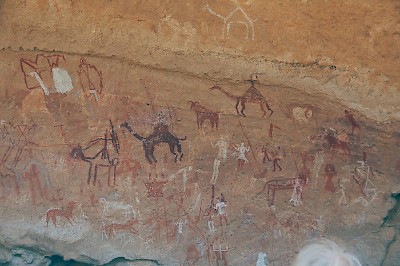
One of the delights of a visit to modern Libya is to tour through the desert, where you will not only be able to see beautiful sand dunes and sun-blackened rocks, but also ancient rock reliefs and paintings, left behind when the land that is now called the Sahara was a savanna.
When these works of art were discovered, people were surprised to discover how ancient they were. All written sources describe Libya as arid, but among the reliefs and paintings were representations of crocodiles, hippopotamuses, and even swimmers. It was, correctly, concluded that these works of art belonged to a period in which the Sahara was still fertile. This was confirmed when petrified forests were discovered.
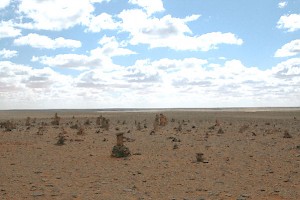
Today, the reliefs and paintings are still problematic. They can, for example, hardly be dated.
Still, it is possible to make a relative chronology of the four art styles, because sometimes, a more recent painting covers an older work of art, but only the animals that are represented, offer a clue for the absolute chronology.
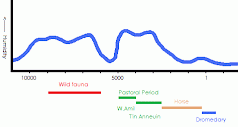
For example, the Period of the Wild Fauna must have preceded the extinction of the long-horned buffalo (pelorovis antiquus), and the Period of the Horse and the Period of the Dromedary must postdate the domestication of these animals. An art history of the Fezzan rock paintings is, therefore, in the first place a history of an ecosystem.
Period of the Wild Fauna
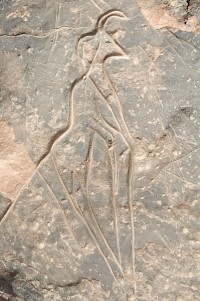
About 12,000 years ago, the last Ice Age came to an end. The planet became warmer, the ice shelves started to melt, and rainfall increased. As a consequence, the Sahara enjoyed a more humid climate than today. It is certain that between about 10,000 and 6,000 BCE, large parts were a savanna with perennial lakes and sufficient vegetation to allow big, wild animals to feed themselves. The petrified trees that are still visible on several places, are silent witnesses to the forests were once there. The moment of greatest humidity appears to have been somewhere around 6,500 BCE.
In this period, there were two schools of art, both dated to c.8,000-6,000. The first one focused on humans, and can mostly be found in Algeria, although there are some examples from Libya as well. The people represented typically have remarkable round heads.
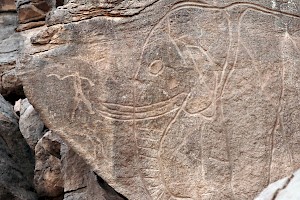
The artists of the second school depicted rhinoceroses, crocodiles, felines, hippopotamuses, giraffes, wild asses, and now extinct long-horned buffaloes (pelorovis antiquus). The best-known example is the amazing Wadi Mathendous, but there are countless other sites, many of which have not yet been investigated.
Often, the animals are shown too large, while the humans - usually hunters with spears - are small. This has been taken as indicative of the fear that the beasts inspired, but in reality we do not know why the prehistoric artists did this.
 Haddat, Elephant |
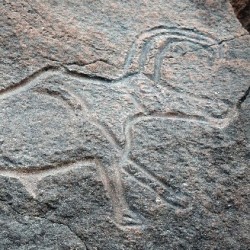 Wadi Mathendous, Buffalo |
 Buffalo and antelope |
 Flintstone tools |
After 6,500, when the great ice sheets had melted and there was less rain, the country started to become more arid, and the sixth millennium witnessed great droughts. The lakes evaporated, leaving behind large deposits of salt; at the same time, most people abandoned the desert.
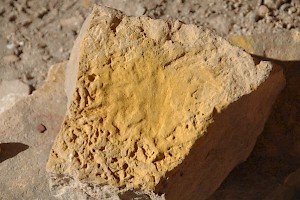
However, at some point, perhaps c.5000 BCE, the arid Sahara started to attract monsoons: the hot air raises and creates a low pressure zone, which attracts wet air from the Ocean. Why this climate change occurred, is not fully understood, but the results are uncontested: there were new lakes, there was pasture, there were new people with better tools, and there were new artists. Their rock paintings are known as "pastoral".
Pastoral Period
By now, the buffalo had become extinct, which offers a clue for dating the new rock art. On the other hand, we start to see domesticated cattle. (For this reason, the Pastoral Period is also called the "Cattle Period".) Weapons offer another clue to establish the date of a painting: the humans who entered the savanna after 5,000, were armed with arches. A final clue is the use of pigments.
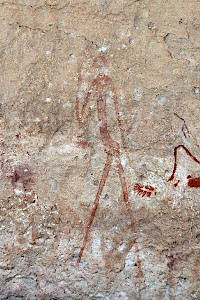
The Pastoral Period can be subdivided into two phases. The first of these lasted from about 5,000 to 4,000, and is called "Wadi Amil". The main subjects are ostriches, elephants, hippopotamuses, and giraffes. This time, the proportions are right: if humans in the Period of the Wild Fauna had been overawed by the wild beasts, this fear had now disappeared.
The second phase, called "Ti'n Anneuin", is easy to recognize because humans are represented as thin, tall people. It is commonly dated to 4,000-2,500, but it may have been briefer; the climate started to change again in c.3,400, and there is some debate whether the desertification was a slow or an abrupt process.
There was another type of art during the Pastoral Period: more to the east, in Egypt, humans were represented as plump figures (e.g., in the famous Cave of the Swimmers). It is not clear whether this school of art was contemporary with the Wadi Amil or Ti'n Anneuin schools, although it certainly belongs to the Pastoral Period.
 Wadi Imla, Archer and ostrich (with additions from the Period of the Horse top right) |
 Wadi Imla, Giraffe |
 Wadi Imla, Cattle |
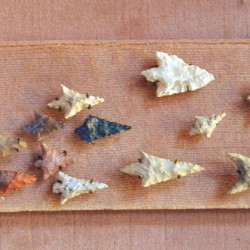 Arrowheads |
Between 3,400 and 2,000 BCE (or earlier), the monsoon retreated to where it is now, and the vegetation gradually disappeared, a process that probably was sped up by overgrazing. The lakes disappeared again, prompting humans and animals to move to the remaining habitable niches and to the edges of the desert. It may be noted that from this moment on, there were two kinds of elephant: the African Savanna Elephant and the North African Elephant (the famous war elephant of the Carthaginians, now extinct).
Period of the Horse
At some stage, the horse was introduced; this may have been as early as 2,500 BCE, and as late as 1,500 BCE. However that may be, we can distinguish a completely novel art style, which betrays life in an arid climate. The people who remained in the desert, were nomads, roaming from one oasis to another. This is the origin of transsaharan trade. If they were sedentary, they lived in caves.
In their art, we no longer find the old animals, and instead see goats, cows, asses, and of course horses. Often, people are represented as triangles, making them look like diabolos. The drawings are rather crude, often no more than lines.
 Wadi Imla, Shepherd |
 Wadi Awis, Warriors |
 Wadi Awis, Warriors and musicians |
 Wadi Imla, Horse |
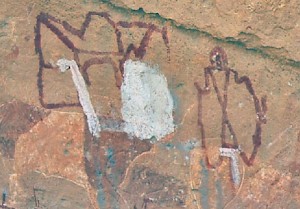
Sometimes, we can see them standing in front of a house - an indication that there were people who lived a sedentary life - or celebrating a party, like the painting in the so-called Cave of the Hunters in the Wadi Awis. Although it has been claimed these people are hunters, the fact that there are trumpeters and people wearing masks suggests that they have something to celebrate. Alternatively, we may be witnessing a war scene.
Period of the Dromedary
The Period of the Dromedary is defined by the domestication of this animal in c.200 BCE. Another new element is the use of writing. Otherwise, it is a continuation of the art of the Period of the Horse. This type of art may be associated with the Garamantes, the inhabitants of one of the largest remaining fertile niches; many of them lived as peasants, others were nomads moving from oasis to oasis as traders of salt and gold.
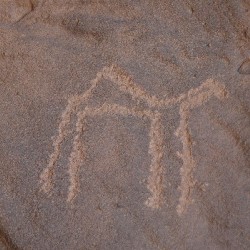 Haddat, Dromedary |
 Wadi Imla, Dromedary, cut into an older work of art |
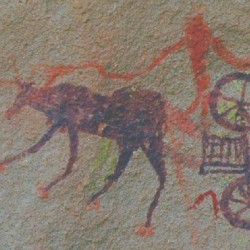 Tina Nivin, Garamantian rock painting of a chariot |
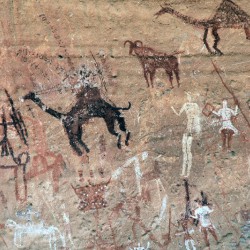 Wadi Imla, Dromedaries and hunters |
It is hard to date the end of the Period of the Dromedary. It may have coincided with the end of Garama, the capital of the Garamantes, in the fifth century CE. If so, climatological factors may again have contributed: the level of the groundwater dropped, making it difficult to continue agriculture, and allowing only a nomadic existence. On the other hand, there had always been Garamantian nomads, and for them, nothing changed. It is possible that some of the art of the Period of the Dromedary belongs to the Middle Ages.
What is certain, however, is that after the end of Garama in the fifth century, there were only few people left in the Sahara. There may have been artists among them, but their number must have been small. Although some rock carvings and paintings may be comparetively young, the age of desert art came to an end in the fifth century.